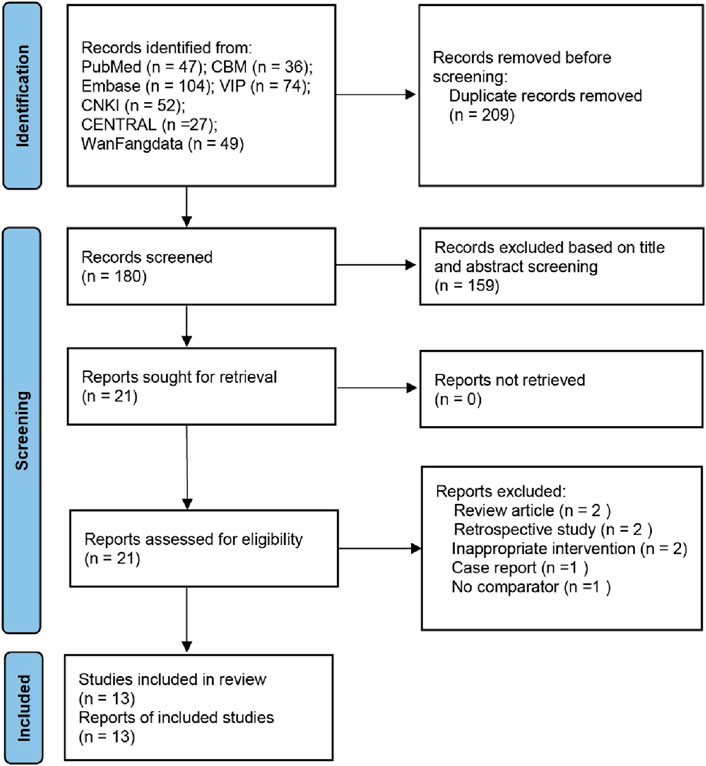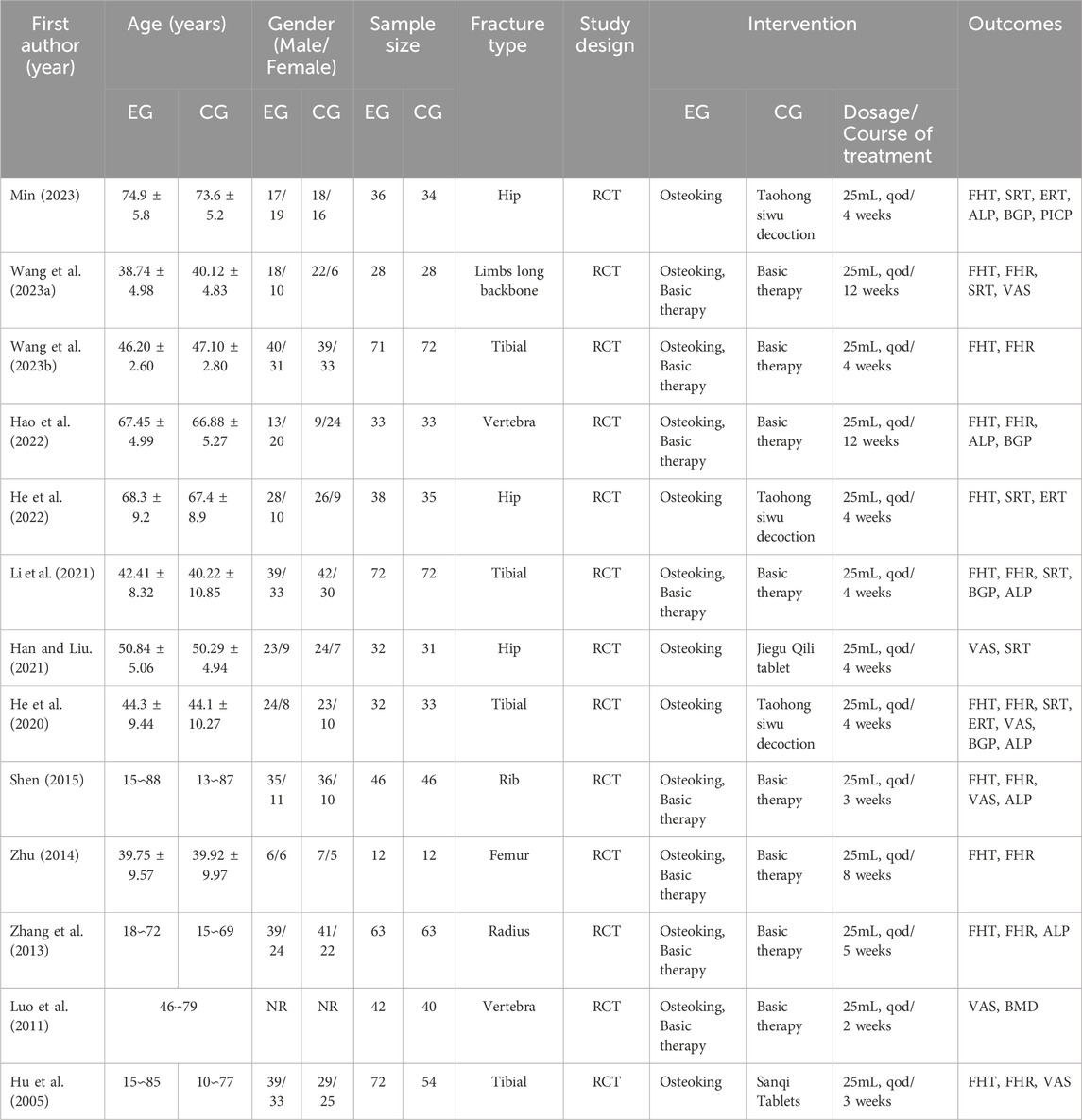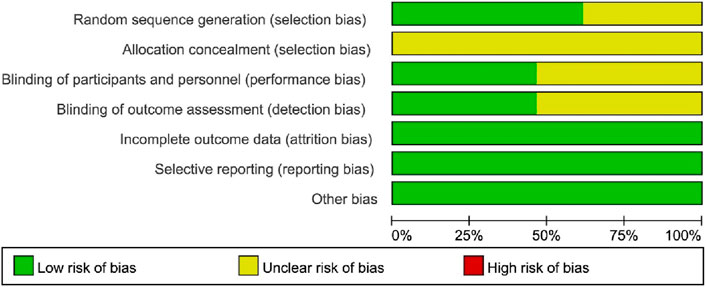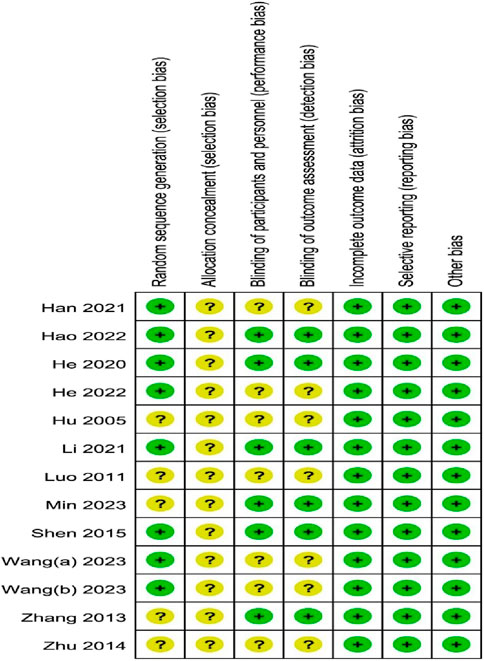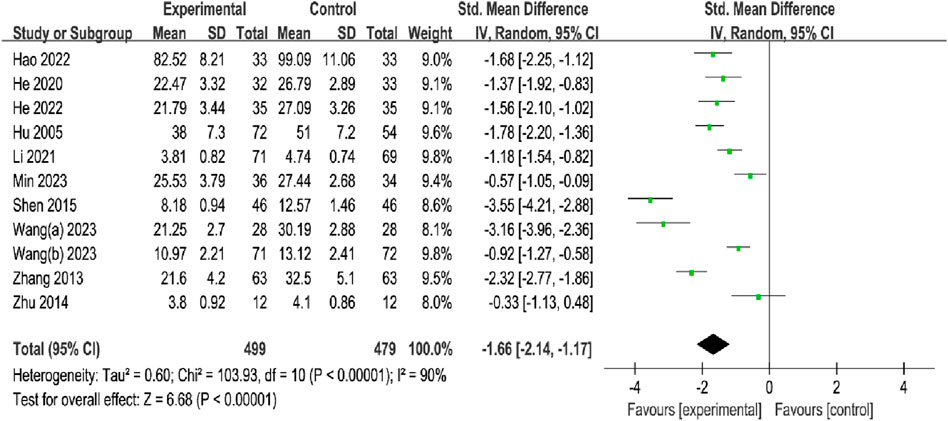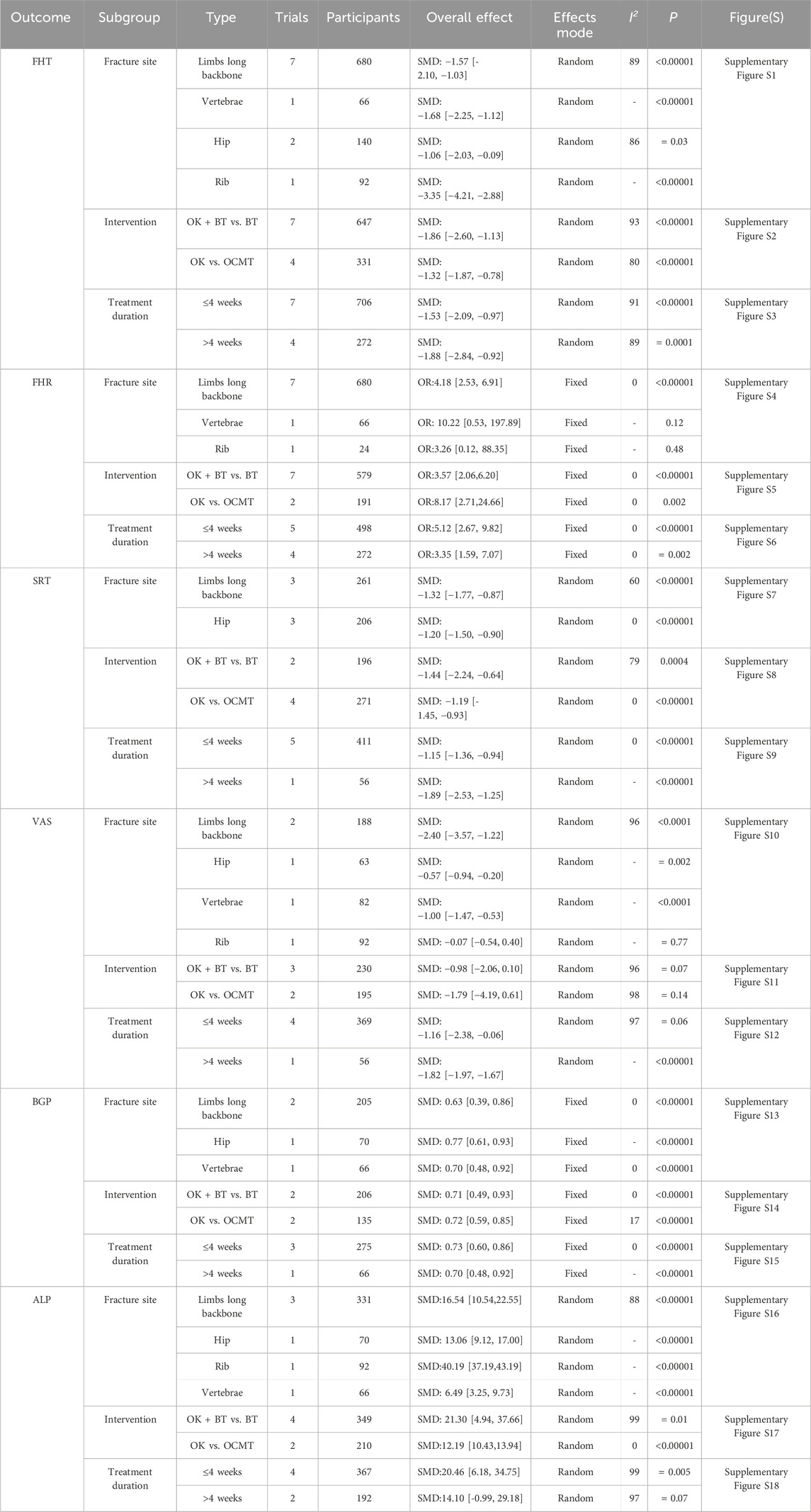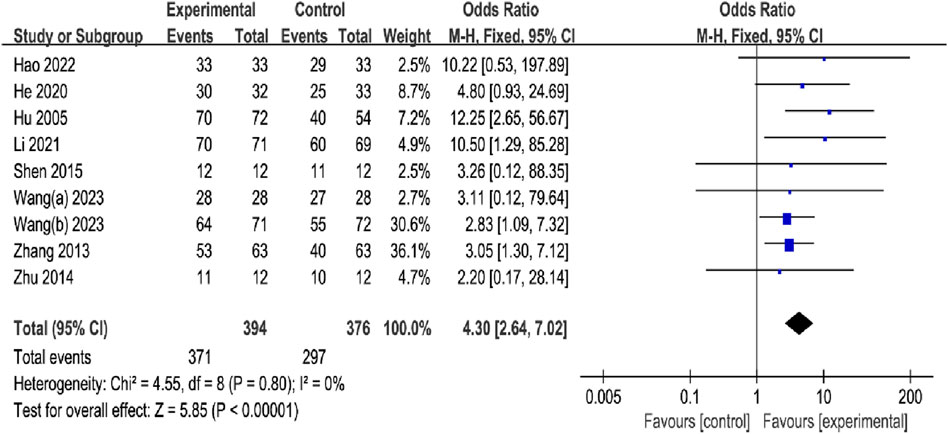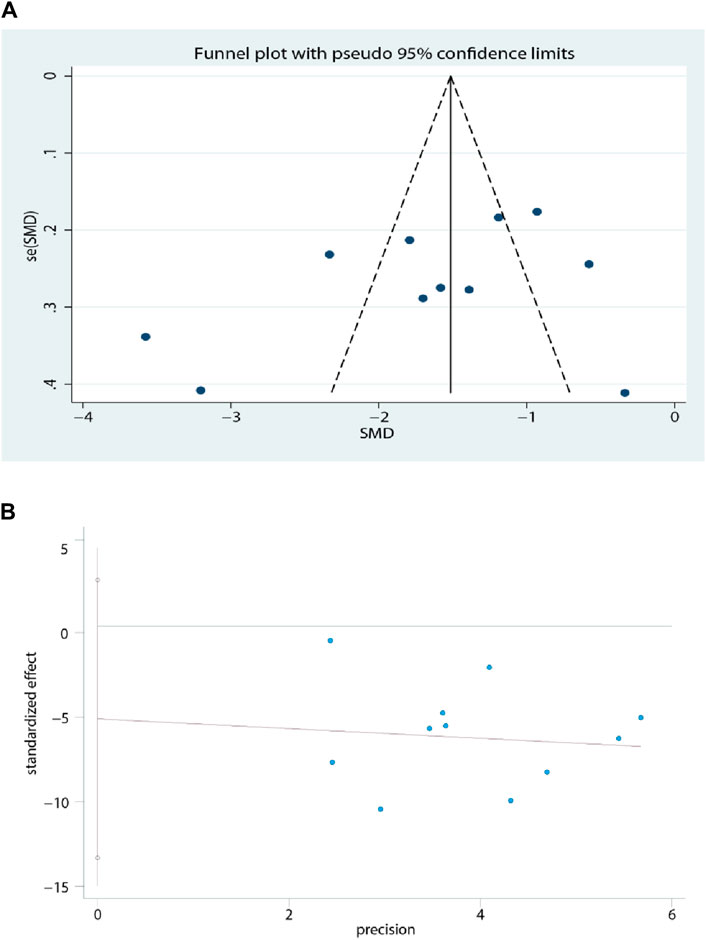- 1The Academy of Chinese Medicine, Hunan University of Chinese Medicine, Changsha, China
- 2Hunan Academy of Chinese Medicine, Changsha, China
- 3Affiliated Hospital of Hunan Academy of Traditional Chinese Medicine, Changsha, China
Background: Osteoking (OK) is prescribed in traditional Chinese medicine to accelerate fracture healing. Although some studies suggest the potential efficacy of OK for fracture healing, the evidence remains inconclusive.
Aim: To systematically evaluate the safety of OK and its effect on fracture healing.
Methods: Relevant authoritative databases were searched until 25 August 2023. Randomized controlled trials (RCTs) of patients with fractures treated with Osteoking were included. We evaluated the risk of bias using the Cochrane tool and performed a meta-analysis using the Review Manager 5.4 software package.
Results: 13 studies involving 1123 participants were included. This meta-analysis showed that compared with observations in the control group, the OK group showed a shortened fracture healing time, increased fracture healing rate, reduced swelling regression time and ecchymosis regression time, and improved bone metabolism. In addition, the included studies did not report any serious side effects associated with the use of OK, and the mild side effects resolved without treatment.
Conclusion: OK therapy is beneficial and safe for accelerating fracture healing, reducing swelling, eliminating ecchymosis, and improving bone metabolism. However, the meta-analysis results do not support OK treatment for improving the fracture healing rate at all fracture sites and reducing pain across all fracture sites. Further original, high-quality studies are needed to validate these findings.
Systematic Review Registration: https://www.crd.york.ac.uk/PROSPERO/display_record.php?RecordID=452430, identifier CRD42023452430.
1 Introduction
Fracture, a common disease to the musculoskeletal system, which can be divided into two categories based on the cause of the injury: traumatic and non-traumatic (Einhorn and Gerstenfeld, 2015). Despite the considerable regenerative potential of bone, fractures remain at high risk for impaired healing (Wildemann et al., 2021). According to available survey reports, 5%–10% of patients with fracture experience impaired fracture healing worldwide, and the prevalence of non-union varies by site (Tzioupis and Giannoudis, 2007). Fracture healing depends on multiple factors such as severity of injury, chronic disease, age, and malnutrition (Ehnert et al., 2020). Prolonged fracture non-union is a chronic disease that affects daily life, functional recovery and increases financial strain. The average direct cost of treating nonunion in long bones is estimated to be $11,333 in the United States, $11,800 in Canada, and £29,204 in the United Kingdom (Papachristou et al., 2021). Accelerated fracture healing is beneficial in reducing non-union and other fracture complications, such as joint stiffness and muscle atrophy. Currently, although standardized treatments for delayed-healing fractures or non-union exist, including autologous bone grafting, clinically effective methods for promoting fracture healing are lacking to date (Schlundt et al., 2018; Colucci et al., 2021). Furthermore, medications commonly used in the early stages of fractures, such as Nonsteroidal Anti-inflammatory Drugs, may inhibit fracture healing (Zhao-Fleming et al., 2018). Therefore, there is an increasing demand for safe and effective adjuvant treatments to accelerate fracture healing.
Chinese herbs have been utilized for thousands of years to promote fracture healing with few side effects and unique benefits. Osteoking (OK) is a proprietary Chinese medicine developed based on the summary of 600 years of fracture medication experience of the Yi ethnic group in China, which is effective in promoting fracture healing (Yuan et al., 2019). Furthermore, it is registered with the US Food and Drug Administration (#200004068) and is recommended by national and international guidelines for the treatment of fractures, osteoarthritis, and other orthopedic conditions (Tong, 2018; Yu et al., 2019). The details of OK, including the source, composition, dosage, extraction procedure, indications, etc., are showed in Supplementary Material S1.
In recent years, an increasing number of clinical studies have evaluated the effects of OK in the treatment of patients with fractures. However, there is a lack of systematic research evaluating the efficacy and safety of OK in these patients. Therefore, to provide a reference for fracture treatment, this study systematically evaluated the safety and efficacy of OK on fracture healing, pain relief, reduction of swelling and ecchymosis, and bone metabolism.
2 Materials and methods
2.1 Protocol and registration
This meta-analysis has been registered in the international Prospective Register of Systematic Reviews, number CRD42023452430 (https://www.crd.york.ac.uk/PROSPERO/display_record.php?RecordID=452430). This meta-analysis was performed and reported according to the Preferred Reporting Items for Systematic Reviews and Meta-Analyses (Page et al., 2021).
2.2 Search strategy
Potentially eligible trials were searched in PubMed, Embase, Cochrane Library, China National Knowledge Infrastructure (CNKI), Chinese Scientific Journals Database (VIP), Chinese Biomedical Literature Database (CBM) and Wanfang data, up to 25 August 2023. The search strategy used medical subject headings terms in combination with free text, such as “Fracture Healing,” “Bone Fracture,” “Broken Bones,” “Chinese Herbal Drugs,” “Chinese Plant Extracts,” and “Osteoking,” etc. The detailed search strategies are presented in Supplementary Material S2.
2.3 Inclusion criteria
2.3.1 Types of studies
RCTs related to the application of OK in fracture healing were searched for. There were no limitations regarding language, publication year, etc.
2.3.2 Types of participants
Patients diagnosed with fracture were included. Fracture was diagnosed by x-ray, computed tomography, and other imaging studies in combination with patient symptoms and physical examination based on a well-defined definition or internationally recognized diagnostic criteria. Any fracture type (fresh, old, open, closed) at any site (irregular, flat, long, or short) was considered acceptable.
2.3.3 Intervention
The same surgical treatment was given to both the control and experimental groups. The experimental group received OK treatment or OK combined with conventional treatment after operation. The control group (CG) received conventional treatment or other traditional Chinese medicine treatments. The ingredients of Osteoking are Carthamus tinctorius L., Panax notoginseng F.H.Chen, Eucommia ulmoides Oliv, Panax ginseng C.A.Mey, Citrus reticulata Blanco D.C., Astragalus hamosus L., Datura metel L., Trionyx sinensis W. and Schizophragma integrifolium Oliv. with 25 mL a bottle.
2.3.4 Outcomes
The primary outcomes included the fracture healing time (FHT) and the fracture healing rate (FHR). The secondary outcomes included the swelling regression time (SRT), ecchymosis regression time (ERT), visual analogue scale (VAS), alkaline phosphatase (ALP), Bone Gla-protein (BGP), and propeptide of type Ⅰprocollagen (PICP).
2.4 Exclusion criteria
(1) The experimental group received other therapeutic interventions with Chinese medicine (such as Chinese herbal medicine and electrical acupuncture).
(2) Protocols, reviews, and animal experimental studies.
(3) Duplicate articles and full-text or non-available data papers.
(4) Studies with academic dishonesties, including plagiarism and falsification of data, were excluded.
2.5 Literature screening and data extraction
Two investigators used a predesigned spreadsheet to separately extract the essential content from the included papers: lead author, year of publication, patient age and sex, type of intervention, fracture type, dosage, course of treatment, and outcome. Any discrepancies in the crosschecking procedures were resolved through discussions. Otherwise, the dispute was subject to arbitration by a third party or another researcher.
2.6 Risk of bias assessment
The methodological quality of all included studies was evaluated independently by two reviewers following the standards recommended in the Cochrane manual (Higgins Jpt, 2021). Discrepancies were resolved by discussion with a third author. Risk of bias for each trial was assessed from seven perspectives: sequence generation, allocation concealment, participant and personnel blinding, outcome assessment blinding, incomplete outcome data, selective reporting, and other bias. There are three levels of risk: high, low, or unclear, based on the evaluation result for each item.
2.7 Statistical analysis
Review Manager 5.4 was applied to all meta-analyses of observational indicators in the selected literature, and the corresponding results were intuitively displayed on the forest plot. In this review, we used mean difference (MD) to pool continuous variables. If each original study outcome indicator unit is inconsistent, the Standard Mean Difference (SMD) alternative MD should be selected. And dichotomous variables were pooled using the odds ratio (OR). All pooling effects are reported with 95% confidence intervals (95% CI). A p-value of less than 0.05 was considered statistically significant. The test for heterogeneity was performed using the I2 statistic and the Cochran Q testing. High heterogeneity was indicated by an I2 statistic >50%. Fixed effects model is used for I2 statistic <50%, otherwise random effects model is selected. Sensitivity analysis tested the stability of the results. Stata 14 was used to estimate publication bias using Egger’s tests.
2.8 Quality of evidence
The quality of evidence for the main outcomes was assessed using the Grading of Recommendations, Assessment, Development and Evaluation (GRADE) approach.
3 Results
3.1 Results of the search
The literature search identified 389 publications; 209 were excluded due to duplication and 159 were excluded by reading the abstracts. After further full-text screening, a total of 13 studies on the effects of OK on fracture healing were included in the analysis based on the screening criteria. A flowchart of the selection process is shown in Figure 1.
3.2 Characteristics of studies
A total of 13 studies (Hu et al., 2005; Luo et al., 2011; Zhang et al., 2013; Zhu, 2014; Shen, 2015; He et al., 2020; Han and Liu, 2021; Li et al., 2021; Hao et al., 2022; He et al., 2022; Wang et al., 2023a; Wang et al., 2023b; Min, 2023) were included in this systematic evaluation, with 573 cases in the experimental group and 550 cases in the control group. All studies had small sample sizes, ranging from 24 to 143 participants. In terms of interventions, patients in the experimental group received OK treatment along with basic treatments, such as surgery and pain control. Patients in the CG were treated with conventional surgery, anti-inflammatory and pain-relieving agents, anti-osteoporotic agents, or other Chinese medicines. Characteristics of studies are shown in Table 1. A summary of the composition characteristics of the preparations included in all studies can be found in the Supplementary Material S3.
3.3 Risk of bias
Seven studies (He et al., 2020; Han and Liu, 2021; Li et al., 2021; Hao et al., 2022; He et al., 2022; Wang et al., 2023a; Wang et al., 2023b) were conducted using a random number table and one trials (Shen, 2015) adopted the lottery method. The remaining studies did not mention the specific randomization methods and were considered to have an unclear risk of bias. Most studies lack a full description of allocation concealment; therefore, the project is mainly assessed as having an “unclear risk of bias.” Although blinding was not reported in some studies, it is unlikely that the assessment of outcome indicators would be compromised by unblinding because some outcome indicators require laboratory instrumentation. Therefore, blinding of participants and personnel, as well as blinding of outcome assessments, was categorized as “low risk of bias.” All included studies reported data for each of the primary outcome indicators in a complete manner, including the number of lost visits and dropouts and the reasons for them; therefore, their attrition bias was assessed as having a low risk of bias. Among the 13 RCTs, we did not find any investigators funded by Osteoking Pharmaceuticals, nor did we find any other potential risks of bias. Therefore, we rated them as “low risk.” The risk of bias was shown in Figure 2 and Figure 3.
3.4 Primary outcomes
3.4.1 Fracture healing time
A total of eleven studies, with 499 participants in the OK group and 479 participants in the CG, reported the FHT. The meta-analysis showed that the OK group may be more favorable for shortening the FHT than the CG using the random-effects model (SMD = −1.66%, 95% CI [−2.14, −1.17], p < 0.00001; Figure 4). Subgroup analyses by fracture site showed that the OK group may have a significant advantage over CG in reducing FHT at different sites (Limbs long backbone: SMD = −1.57, 95% CI [−2.10, −1.03], p < 0.00001; Vertebrae: SMD = −1.68, 95% CI [−2.25, −1.12], p < 0.00001; Hip: SMD = −1.06, 95% CI [−2.03, −0.09], p = 0.03; Rib: SMD = −3.55, 95% CI [−4.21, −2.88], p < 0.00001; Table 2; Supplementary Figure S1). In addition, subgroup analyses based on intervention modality suggested that OK in combination with conventional treatment may be superior to conventional treatment, and OK group may be more effective than other TCM therapies (OK + Basic therapy vs. Basic therapy: SMD = −1.86, 95% CI [−2.60, −1.13], p < 0.00001; OK vs. Other Chinese Medicine Therapy (OCMT): SMD = −1.32, 95% CI [−2.14, −1.17], p < 0.00001; Table 2; Supplementary Figure S2). In the subgroup analysis of treatment time, the result showed that the OK group may have a substantial benefit over CG, regardless of the duration of treatment (≤4 weeks: SMD = −1.53%, 95% CI [−2.09, −0.97], p < 0.00001; >4 weeks: SMD = −1.88%, 95% CI [−2.84, −0.92], p < 0.00001; Table 2; Supplementary Figure S3).
3.4.2 Fracture healing rate
A total of nine studies, with 394 participants in the OK groups and 376 participants in the CG, reported the FHR. The meta-analysis showed that OK group was more favorable for increasing fracture healing rate compared to CG with the fixed effects model (OR = 4.30%, 95% CI [2.64, 7.02], p < 0.00001; Figure 5). Subgroup analyses by fracture site showed that the OK group may have a significant advantage over CG in improving the fracture healing rate at Limbs long backbone (OR = −1.57%, 95% CI [−2.10, −1.03], p < 0.00001; Table 2; Supplementary Figure S4). However, the OK group showed no obvious improvement in healing rates of the vertebrae and rib (Table 2; Supplementary Figure S4). In addition, subgroup analyses based on intervention modality suggested that OK in combination with conventional treatment may be superior to conventional treatment, and OK group was more effective than other Chinese medicine therapies (OK + Basic therapy vs. Basic therapy: OR = 3.57%, 95% CI [ 2.06,6.20], p < 0.00001; OK vs. OCMT: OR = 8.17%, 95% CI [2.71,24.66], p = 0.0002; Table 2; Supplementary Figure S5). In the subgroup analysis of treatment time, the result showed that the OK group may have a substantial benefit over CG, regardless of the duration of treatment (≤4 weeks: OR = 5.12%, 95% CI [2.67,9.82], p < 0.00001; >4 weeks: OR = 3.35%, 95% CI [1.59, 7.07], p < 0.00001; Table 2; Supplementary Figure S6).
3.5 Secondary outcomes
3.5.1 Swelling regression time
A total of six studies, with 237 participants in the OK group and 230 participants in the CG, reported the SRT. The meta-analysis showed that the OK group was more favorable for the reduction of swelling regression time compared to the CG with the fixed effects model (SMD = −1.23%, 95% CI [−1.45, −1.02], p < 0.00001; Figure 6). In subgroup analyses, there were significant differences between fracture site, intervention method, and treatment duration subgroups (Table 2; Supplementary Figures S7–9).
3.5.2 Ecchymosis regression time
A total of three studies, with 106 participants in the OK groups and 102 participants in the CG, reported the ERT. The meta-analysis showed that the OK group may be more favorable for reducing ecchymosis regression time compared to the CG group with the random effects model (MD = −4.64, 95% CI [−5.89, −3.39], p < 0.00001; Figure 7).
3.5.3 Visual analogue scale
A total of five studies, with 222 participants in the OK group and 203 participants in the CG, reported the VAS. The meta-analysis showed that the OK group may have a significant reduction in pain compared to the CG group with the random effects model (MD = −1.30%, 95% CI [−2.15, −0.45], p = 0.003; Figure 8). Subgroup analyses by fracture site showed that the OK group may have a significant advantage over CG in relieving pain at Limbs long backbone, Hip, and vertebrae, however, there was no obvious difference in the ribs (Table 2; Supplementary Figure S10). Additionally, there was no significant difference between the two groups in the subgroup analysis based on the intervention method (Table 2; Supplementary Figure S11). According to the subgroup analysis based on treatment duration, there was no significant difference in short-term pain relief efficacy between the OK group and CG (Table 2; Supplementary Figure S12).
3.5.4 Bone Gla-protein
A total of four studies, with 172 participants in the OK group and 169 participants in the CG, reported the BGP. The meta-analysis showed that OK treatment may have a significant increase in BGP vs. CG with the fixed effects model (MD = 0.72%, 95% CI [0.61, 0.83], p < 0.00001; Figure 9). In the subgroup analyses, significant differences were observed between the fracture site, intervention method, and treatment duration subgroups (Table 2; Supplementary Figures S13–15).
3.5.5 Alkaline phosphatase
A total of six studies, with 281 participants in the OK group and 278 participants in the CG, reported the ALP. The meta-analysis showed that OK treatment may have a significant improvement in ALP compared with that in the CG using the random-effects model (MD = 18.36, 95% CI [8.00, 28.72], p = 0.0005; Figure 10). In subgroup analyses, there were significant differences between fracture site, intervention method, and treatment duration subgroups (Table 2; Supplementary Figures S16–18).
3.5.6 Type I procollagen carboxy-terminal peptide
A total of two studies, with 68 participants in the OK group and 67 participants in the CG, reported PICP. The meta-analysis showed that OK treatment may have a significant reduction in PICP compared with that in the CG with the fixed-effects model (MD = −11.77%, 95% CI [−14.09, −9.45], p < 0.00001; Figure 11).
3.5.7 Adverse events
One trial (Wang et al., 2023a) reported two cases of dry mouth, one case of oral ulcer, two cases of skin itching, and four cases of gastrointestinal reactions in the OK group, and two cases of dry mouth, two cases of oral ulcer, and three cases of gastrointestinal reactions in the CG. There was no significant difference in the incidence of adverse reactions between the two groups. In one study (Shen, 2015), two patients in the OK group reported adverse effects, such as dry mouth, that were not treated and resolved spontaneously after 2–6 h. None of the ten RCTs reported adverse event information for all included studies (Luo et al., 2011; Zhang et al., 2013; Zhu, 2014; He et al., 2020; Han and Liu, 2021; Li et al., 2021; Hao et al., 2022; He et al., 2022; Liu et al., 2022; Wang et al., 2023b; Min, 2023). In addition, in another study (Hu et al., 2005), five patients experienced side effects, such as dizziness, but the symptoms were mild and resolved on their own.
3.6 Sensitivity analysis
In this review, we performed sensitivity analyses of the primary outcomes by removing trials individually. The results showed that the pooled analysis results were stable for the primary outcomes (Supplementary Table S1).
3.7 Publication bias
Funnel plots and Egger’s tests were performed only for outcome measures in more than ten studies. The funnel plot for the FHT was symmetric, as shown in Figure 12A. Egger’s test for the FHT indicated no significant publication bias (t = −1.41, p = 0.192) in the included studies (Figure 12B).
3.8 Evidence quality assessment
A summary of the GRADE results is provided in Table 3. There was a low level of evidence for FHT, FHR, and SRT, and very low evidence for the remaining outcomes based on the GRADE approach.
4 Discussion
This systematic review and meta-analysis assessed the efficacy and safety of OK for fracture healing. In this review, OK therapy was found to be beneficial and safe for accelerating fracture healing, reducing swelling, eliminating bruising, improving bone metabolism, and promoting postoperative recovery. Fracture healing is influenced by many factors such as fracture site, severity of trauma, chronic illness, malnutrition, and use of certain medications (Rodham et al., 2023). Therefore, although we performed a subgroup analysis of the outcome indicators according to fracture site, intervention type, and treatment course, the heterogeneity of some outcome indicators remained high. It is worth noting that the results of the VAS were not fully consistent with the results of the subgroup analysis based on the treatment course and intervention type.
In the systematic review, we found that the most commonly used dose of OK to promote fracture healing is 25 mL every other day, according to the included literature. Furthermore, the majority of OK courses were less than or equal to 4 weeks. The duration of intervention in the four studies was greater than 4 weeks; two of the studies (Zhu, 2014; Wang et al., 2023b) had a diagnosis of nonunion, one study (Zhang et al., 2013) had a diagnosis of comminuted fractures; and one study (Hao et al., 2022) had a diagnosis of osteoporotic fractures in older patients. The results have shown that a course of OK lasting less than or equal to 4 weeks can effectively promote fracture healing, but nonunion fractures, older patients, or more serious injuries may require a longer period of time. In addition, there were few reports on side effects in the literature included in this review, with only three studies mentioning side effects. No serious side effects were observed in the included studies, and mild side effects that did occur resolved on their own without treatment. However, further research is required to determine the specific causes of the adverse effects of surgical procedures and other medications.
OK has been used for fracture healing in China for more than 600 years. However, no published studies have evaluated the efficacy and safety of OK in fracture healing. According to the theory of Chinese medicine, the healing of bone fractures requires the activation of blood circulation and elimination of blood stasis, as well as the strengthening of tendons and bones. The combination of herbs in OK works to reduce pain in the acute phase and promotes recovery in the remission phase. OK is composed of C. tinctorius L., P. notoginseng F.H.Chen, E. ulmoides Oliv, P. ginseng C.A.Mey, C. reticulata Blanco D.C., A. hamosus L., D. metel L., T. sinensis W., S. integrifolium Oliv., which has the effects of activating blood and replenishing qi, bone and tendon (http://www.worldfloraonline.org, date of visit: 17 November 2023). Carthamus tinctorius L. has anti-inflammatory and analgesic effects, and its mechanism is related to increasing the release of interleukin-4 and reducing interleukin-1β (Yousefi et al., 2021). In addition, Hydroxysafflor Yellow A promotes bone mineralization and inhibits bone resorption, thereby reversing glucocorticoid-induced osteoporosis (Nie et al., 2019). The anti-inflammatory effect of P. notoginseng F.H.Chen is mainly through inhibiting the secretion of TNF-α and IL-6 in macrophages induced by lipopolysaccharide (Wang et al., 2014). Citrus reticulata Blanco D.C. active ingredient tangeretin activates AMPK-PGC1-α pathway and enhances mitochondrial biosynthesis, showing the potential to protect muscles and bones, thereby improving exercise performance (Kou et al., 2018). The chemical constituents of Panax ginseng C.A.Mey regulate and maintain the normal physiological functions of the immune system and promote specific or non-specific immunity (Ratan et al., 2021b). Eucommia ulmoides leaf extract can regulate the diversity of intestinal microflora and increase the content of short-chain fatty acids to exert bone protection (Zhao et al., 2020). Astragalus hamosus L. can promote angiogenesis by inhibiting inflammatory response and upregulating the expression of VEGF and p-AKT/AKT proteins (Wang et al., 2021). Datura metel L. has the effect of inhibiting cholinergic nerves, which relieves muscle spasms and pain (Ratan et al., 2021b). Schizophragma integrifolium Oliv. is mainly composed of terpenoids, aromatic hydroxyls, and other components that have anti-inflammatory, analgesic, and detumescent effects (Zeng et al., 2009). The bioactive substances extracted from T. sinensis W. have the effects of anti-tumor, anti-inflammatory and improving immune function (Sun et al., 2021). Pharmacological studies have shown that OK stimulates the Wnt signaling pathway by downregulating the serum levels of Dickkopf-related protein 1 in fractured rabbits to promote bone formation, increase bone mineral density, and treat fractures (Wang et al., 2014). Additionally, it has also been shown that OK can increase levels of basic fibroblast growth factor, platelet-derived growth factor, and vascular endothelial growth factor in fracture rabbits, promoting bone repair and remodeling (Wu and Zhan, 2017). Moreover, the clinical treatment results showed that OK was more effective in improving microcirculation, removing blood clots and metabolites at the fracture site, accelerating soft tissue injury repair and edema absorption, and reducing inflammatory exudate stimulation of nerve endings (Yuan et al., 2019; Cai et al., 2021).
Some limitations of this study are listed below. First, all studies were conducted in China, and research from other countries, regions, and data from other populations were lacking, limiting their applicability. Second, this review selected all fracture types to include all RCTs on OK interventions for fracture healing, which increased the heterogeneity of the results. Third, some studies had small sample sizes and low quality, which negatively impacted the strength of the evidence for the research findings. Therefore, additional original studies with higher quality, standardization, and more fracture types are required to confirm these conclusions.
To improve future trials on this topic, we have some insights. Firstly, to ensure the transparency of clinical trial research and the ethical and scientific nature of the research, the program should be registered on the international clinical trial registration platform. Tests should be reported in detail in accordance with the Consolidated Standard for Reported Trials statement. Secondly, it is recommended that future clinical trials employ the most appropriate randomization method and blind method, and that the sample size be estimated in a reasonable manner. Thirdly, longer follow-up is necessary to determine the potential benefits of OK on the reduction of re-fractures. Fourthly, Patients enrolled in clinical trials should be excluded if they have underlying conditions that interfere with fracture healing. Fifthly, the selection of primary outcome indicators should align with internationally or domestically recognized efficacy evaluation indicators.
5 Conclusion
In this review, we found that OK therapy was beneficial and safe for accelerating fracture healing, reducing swelling, eliminating bruising, and improving bone metabolism. However, the meta-analysis results do not support OK treatment for improving the FHR at all fracture sites and reducing pain across all fracture sites. Current evidence suggests that OK may be an effective treatment option for patients with fractures. Further well-designed, high-quality studies are needed to validate these findings.
Data availability statement
The original contributions presented in the study are included in the article/Supplementary Material, further inquiries can be directed to the corresponding authors.
Author contributions
LZ: Conceptualization, Writing–original draft. HK: Investigation, Software, Writing–original draft. ZZ: Investigation, Writing–review and editing. KR: Investigation, Software, Writing–review and editing. YY: Conceptualization, Investigation, Writing–original draft. ZP: Conceptualization, Software, Writing–original draft. HZ: Conceptualization, Investigation, Writing–original draft. KL: Writing–original draft. LO: Conceptualization, Writing–review and editing. JK: Writing–review and editing.
Funding
The author(s) declare financial support was received for the research, authorship, and/or publication of this article. This research was funded by the following programs: China Postdoctoral Science Foundation (2023M731070), Hunan Provincial Science and Technology Department (2023JJ60118), Hunan University of Traditional Chinese Medicine Graduate Student Innovation Projects (2023CX18), and Hunan Academy of Chinese Medicine (202129).
Conflict of interest
The authors declare that the research was conducted in the absence of any commercial or financial relationships that could be construed as a potential conflict of interest.
Publisher’s note
All claims expressed in this article are solely those of the authors and do not necessarily represent those of their affiliated organizations, or those of the publisher, the editors and the reviewers. Any product that may be evaluated in this article, or claim that may be made by its manufacturer, is not guaranteed or endorsed by the publisher.
Supplementary material
The Supplementary Material for this article can be found online at: https://www.frontiersin.org/articles/10.3389/fphar.2024.1363421/full#supplementary-material
References
Cai, L. X., Liu, Y. L., Wu, F., Huo, Z. Q., and Yang, H. Y. (2021). Clinical study on low-intensity pulsed ultrasound combined with henggu gushang yuhe mixture in promoting the healing of osteoporotic distal radius fracture. J. Guangzhou Univ. Traditional Chin. Med. 38 (2), 289–293. doi:10.13359/j.cnki.gzxbtcm.2021.02.013
Colucci, S. C., Buccoliero, C., Sanesi, L., Errede, M., Colaianni, G., Annese, T., et al. (2021). Systemic administration of recombinant irisin accelerates fracture healing in mice. Int. J. Mol. Sci. 22 (19), 10863. doi:10.3390/ijms221910863
Ehnert, S., Rinderknecht, H., Aspera-Werz, R. H., Häussling, V., and Nussler, A. K. (2020). Use of in vitro bone models to screen for altered bone metabolism, osteopathies, and fracture healing: challenges of complex models. Arch. Toxicol. 94 (12), 3937–3958. doi:10.1007/s00204-020-02906-z
Einhorn, T. A., and Gerstenfeld, L. C. (2015). Fracture healing: mechanisms and interventions. Nat. Rev. Rheumatol. 11 (1), 45–54. doi:10.1038/nrrheum.2014.164
Han, Y. F., and Liu, Y. W. (2021). Clinical analysis of henggu gushangyu mixture in the treatment of femoral neck fracture. World Latest Med. Inf. 21 (35), 211–212. doi:10.3969/j.issn.1671-3141.2021.35.084
Hao, M., Liu, X. H., Yao, X. W., Pan, S., Cao, R., and Cao, J. H. (2022). Effects of osteoking on bone metabolism and bone mineral density after surgery of osteoporotic vertebral compression fractures. Eval. Analysis Drug-Use Hosp. China 22 (6), 664–667. doi:10.14009/j.issn.1672-2124.2022.06.007
He, B. J., Mao, Q., Hua, J., and Tong, P. J. (2020). Application of Osteoking to patients who received surgery for treatment of middle -lower tibial fractures and its mechanism of action. J. Trad. Chin. Orthop. Trauma 32 (5), 15–21. doi:10.3969/j.issn.1001-6015.2020.05.004
He, P. L., Yue, C., Chen, J. M., Ma, M. X., Yang, G. Y., Wang, Q. Y., et al. (2022). Observation on the curative effect of Henggu Gushangyu Mixture in the treatment of femoral intertrochanteric fracture after internal fixation. Fujian J. TCM 53 (5), 60–62. doi:10.13260/j.cnki.jfjtcm.012487
Higgins Jpt, T. J. C. J. (2021). Cochrane handbook for systematic reviews ofInterventions. Available at: www.training.cochrane.org/handbook (Accessed February 2021).
Hu, M., Zhao, H. B., Wang, B., Liang, H. S., Zhang, C. Q., Zheng, H. Y., et al. (2005). Clinical observation on promoting postoperative healing of lower tibial fractures by henggu gushangyu mixture. CJITWM 25 (2), 160–161. doi:10.3321/j.issn:1003-5370.2005.02.017
Kou, G., Li, Z., Wu, C., Liu, Y., Hu, Y., Guo, L., et al. (2018). Citrus tangeretin improves skeletal muscle mitochondrial biogenesis via activating the AMPK-PGC1-α pathway in vitro and in vivo: a possible mechanism for its beneficial effect on physical performance. J. Agric. Food Chem. 66 (45), 11917–11925. doi:10.1021/acs.jafc.8b04124
Li, C. Y., Wu, G. Z., Chen, R., Zhang, W., Zhang, P. J., and Tang, J. (2021). Effect of Osteoking combined with closed reduction and percutaneous locking plate fixation on postoperative healing of tibial fracture. China Med. Her. 18 (33), 94–98. doi:10.3969/j.issn.1673-7210.2021.33.yycyzx202133022
Liu, Z., Zhao, X. H., Luo, W. M., and Wang, L. (2022). The effect of osteoking on postoperative fracture healing of femoral neck fracture. Int. J. Trad. Chin. Med. 44 (10), 1122–1126. doi:10.3760/cma.j.cn115398-20211021-00229
Luo, D. J., Zhao, H. B., Zhou, X., Dong, X. L., Li, L. Z., Wang, W. Z., et al. (2011). Efficacy evaluation of salmon calcitonin combined with Henggu Gushangyu Mixture in the treatment of lumbar OPF. Chin. J. Endocr. Surg. 5 (3), 158–160. doi:10.3760/cma.j.issn.1674-6090.2011.03.005
Min, R. (2023). Analysis of therapeutic effect of henggu gushang healing agent combined with PFNA on intertrochanteric fracture of femur. J. JIANGXI Univ. CM 35 (4), 43–46.
Nie, Z., Deng, S., Zhang, L., Chen, S., Lu, Q., and Peng, H. (2019). Crocin protects against dexamethasone-induced osteoblast apoptosis by inhibiting the ROS/Ca2+-mediated mitochondrial pathway. Mol. Med. Rep. 20 (1), 401–408. doi:10.3892/mmr.2019.10267
Page, M. J., Mckenzie, J. E., Bossuyt, P. M., Boutron, I., Hoffmann, T. C., Mulrow, C. D., et al. (2021). The PRISMA 2020 statement: an updated guideline for reporting systematic reviews. BMJ 372, n71. doi:10.1136/bmj.n71
Papachristou, D. J., Georgopoulos, S., Giannoudis, P. V., and Panagiotopoulos, E. (2021). Insights into the cellular and molecular mechanisms that govern the fracture-healing process: a narrative review. J. Clin. Med. 10 (16), 3554. doi:10.3390/jcm10163554
Ratan, Z. A., Youn, S. H., Kwak, Y. S., Han, C. K., Haidere, M. F., Kim, J. K., et al. (2021b). Adaptogenic effects of Panax ginseng on modulation of immune functions. J. Ginseng Res. 45 (1), 32–40. doi:10.1016/j.jgr.2020.09.004
Schlundt, C., Bucher, C. H., Tsitsilonis, S., Schell, H., Duda, G. N., and Schmidt-Bleek, K. (2018). Clinical and research approaches to treat non-union fracture. Curr. Osteoporos. Rep. 16 (2), 155–168. doi:10.1007/s11914-018-0432-1
Shen, L. (2015) Clinical study on traumatic rib fracture treated with henggu gushangyu mixture. China: Kunming medical university.
Sun, J., Chen, W., Wen, B., Zhang, M., Sun, H., Yang, X., et al. (2021). Biejiajian pill inhibits carcinogenesis and metastasis via the akt/GSK-3β/snail signaling pathway in hepatocellular carcinoma. Front. Pharmacol. 12, 610158. doi:10.3389/fphar.2021.610158
Tong, P. J. (2018). Guidelines for diagnosis and treatment of knee osteoarthritis with integrated traditional Chinese and western medicine. Natl. Med. J. China 98 (45), 3653–3658. doi:10.3760/cma.j.issn.0376-2491.2018.45.005
Tzioupis, C., and Giannoudis, P. V. (2007). Prevalence of long-bone non-unions. Injury 38 (Suppl. 2), S3–S9. doi:10.1016/s0020-1383(07)80003-9
Wang, B. S., Ma, X. F., Zhang, C. Y., Li, Y. X., Liu, X. Z., and Hu, C. Q. (2021). Astragaloside IV improves angiogenesis and promotes wound healing in diabetic rats via the activation of the SUMOylation pathway. Biomed. Environ. Sci. 34 (2), 124–129. doi:10.3967/bes2021.018
Wang, H. X., Wen, Q., Liu, L., and Meng, D. F. (2023a). Clinical study of Henggu Gushang Yuheji combined with Ossotide for injection in treatment of tibial plateau fracture. Drugs & Clin. 38 (2), 432–436. doi:10.7501/j.issn.1674-5515.2023.02.033
Wang, T., Dai, Y., Dun, Y., Zhang, C., Wan, J., Deng, L., et al. (2014). Chikusetsusaponin V inhibits inflammatory responses via NF-κB and MAPK signaling pathways in LPS-induced RAW 264.7 macrophages. Immunopharmacol. Immunotoxicol. 36 (6), 404–411. doi:10.3109/08923973.2014.960088
Wang, Y. W., Li, Z., Jin, Y. M., Gu, H., Zhu, B., and Fan, Y. H. (2023b). Observation on the effect of henggu gushangyu mixture on postoperative nonunion of long bone fracture. Med. Pharm. Yunnan 44 (2), 33–37.
Wildemann, B., Ignatius, A., Leung, F., Taitsman, L. A., Smith, R. M., Pesántez, R., et al. (2021). Non-union bone fractures. Nat. Rev. Dis. Prim. 7 (1), 57. doi:10.1038/s41572-021-00289-8
Yousefi, F., Arab, F. L., Rastin, M., Tabasi, N. S., Nikkhah, K., and Mahmoudi, M. (2021). Comparative assessment of immunomodulatory, proliferative, and antioxidant activities of crocin and crocetin on mesenchymal stem cells. J. Cell. Biochem. 122 (1), 29–42. doi:10.1002/jcb.29826
Yu, B., Wu, B., Tang, P. F., and Zhang, Y. Z. (2019). Guidelines on diagnosis and treatment of open fractures in China. Chin. J. Orthop. Trauma 21 (11), 921–928. doi:10.3760/cma.j.issn.1671-7600.2019.11.001
Yuan, X., Wu, Y. J., Jiao, J. L., Wu, C., Guo, Y. Q., Zheng, H., et al. (2019). Pharmacological action and clinical application of Yi medicine osteoking. Chin. J. Mod. Appl. Pharm. 36 (3), 372–376. doi:10.13748/j.cnki.issn1007-7693.2019.03.024
Zeng, G., Liang, Q. H., Liu, S., Wu, H. J., and You, W. H. (2009). Study on chemical constituents and anti-inflammatory activity of volatile oil from S.divaricata. Nat. Prod. Res. Dev. 21 (0), 129–131.
Zhang, Z. B., Wang, P., Luo, H. L., and Liu, T. (2013). Operation combined with traditional Chinese medicine treatment of distal radius comminuted fracture and intra-articular fracture curative effect observation. Asia-Pacific Tradit. Med. 9 (6), 115–116. doi:10.3969/j.issn.1673-2197.2013.06.057
Zhao, X., Wang, Y., Nie, Z., Han, L., Zhong, X., Yan, X., et al. (2020). Eucommia ulmoides leaf extract alters gut microbiota composition, enhances short-chain fatty acids production, and ameliorates osteoporosis in the senescence-accelerated mouse P6 (SAMP6) model. Food Sci. Nutr. 8 (9), 4897–4906. doi:10.1002/fsn3.1779
Zhao-Fleming, H., Hand, A., Zhang, K., Polak, R., Northcut, A., Jacob, D., et al. (2018). Effect of non-steroidal anti-inflammatory drugs on post-surgical complications against the backdrop of the opioid crisis. Burns Trauma 6, 25. doi:10.1186/s41038-018-0128-x
Keywords: Osteoking, fracture healing, randomized controlled trial, meta-analysis, systematic review
Citation: Zhang L, Kuang H, Zhang Z, Rong K, Yuan Y, Peng Z, Zhao H, Liu K, Ou L and Kuang J (2024) Efficacy and safety of Osteoking on fracture healing: a systematic review and meta-analysis. Front. Pharmacol. 15:1363421. doi: 10.3389/fphar.2024.1363421
Received: 30 December 2023; Accepted: 21 May 2024;
Published: 10 June 2024.
Edited by:
Zhiyong Hou, Third Hospital of Hebei Medical University, ChinaReviewed by:
Jian Weng, University of Michigan, United StatesNan Jiang, Southern Medical University, China
Copyright © 2024 Zhang, Kuang, Zhang, Rong, Yuan, Peng, Zhao, Liu, Ou and Kuang. This is an open-access article distributed under the terms of the Creative Commons Attribution License (CC BY). The use, distribution or reproduction in other forums is permitted, provided the original author(s) and the copyright owner(s) are credited and that the original publication in this journal is cited, in accordance with accepted academic practice. No use, distribution or reproduction is permitted which does not comply with these terms.
*Correspondence: Liang Ou, b3VsaWFuZzIwMjBAMTYzLmNvbQ==; Jianjun Kuang, MTM3ODYxNjU2NTZAMTYzLmNvbQ==
 Le Zhang
Le Zhang Haomin Kuang1
Haomin Kuang1 Liang Ou
Liang Ou